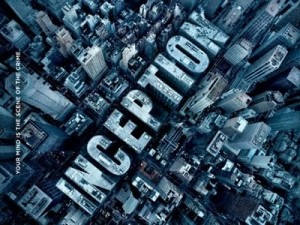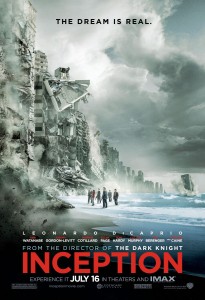Inception: A Kabbalistic Take on the Film (Part 3)
By Asher Crispe: December 20, 2012: Category Inspirations, Living with the Times
 If you’re the type that likes to astral project during sleep sessions, then you might be familiar with the paradox of ‘falling’ upwards or flying in your dreams. Our excursion through the Four Worlds can happen in the reverse direction from how we described it in the last article. In that case, we focused on the top-down approach (going ‘down’ to sleep and waking ‘up’) which was situated from the perspective of our consciousness of Divinity in the world of Emanation. Now, we will turn the tables and assume that our starting perspective is from the lowest world–the world of Action. In this world-context I experience the world as the true ‘something’ and Divinity as ‘nothing.’ Chassidic teachings consider this as a foregrounding of a natural world consciousness (olamot b’pashitut) while simultaneously backgrounding questions of Divinity which cast long shadows of doubt in that these spiritual dimensions are no longer apparent (Elokut b’hitchadshut). In short, I find it easy to believe in the world because that is what I am consciously aware of, while the existence and involvement of a Creator presents a challenge to me.
If you’re the type that likes to astral project during sleep sessions, then you might be familiar with the paradox of ‘falling’ upwards or flying in your dreams. Our excursion through the Four Worlds can happen in the reverse direction from how we described it in the last article. In that case, we focused on the top-down approach (going ‘down’ to sleep and waking ‘up’) which was situated from the perspective of our consciousness of Divinity in the world of Emanation. Now, we will turn the tables and assume that our starting perspective is from the lowest world–the world of Action. In this world-context I experience the world as the true ‘something’ and Divinity as ‘nothing.’ Chassidic teachings consider this as a foregrounding of a natural world consciousness (olamot b’pashitut) while simultaneously backgrounding questions of Divinity which cast long shadows of doubt in that these spiritual dimensions are no longer apparent (Elokut b’hitchadshut). In short, I find it easy to believe in the world because that is what I am consciously aware of, while the existence and involvement of a Creator presents a challenge to me.
Under such circumstances, when I fall asleep I fall upwards. My soul ascends from the confinements of a natural world view and gains access to more spiritually expansive environments. I have to shift my awareness from the physical world of Action into the world immediately above it (Formation) and then I will ‘awaken’ there. This retuning of my mind manages to switch between what is conscious and what is unconscious. For instance, if I am fully focused on what I am doing (say playing a basketball game) then I don’t have time to speak about it. If I am talking too much on the court I will get distracted away from the primary goal which is controlling the ball. Likewise, I cannot think too much about the game. If I get lost in thought my body will slow down and become less ‘in the game.’ When one is caught doing this, one’s teammates usually shout something to the effect of ‘why are you asleep’ in the game. Hence, ‘elevation’ amounts to a form of ‘abstraction’ from the concrete actions that I am engaged in.
One of the general sets of correspondence that relates to the Four worlds has to do with the garments of the soul and the powers of the soul. The three lower worlds of Creation, Formation and Action are representative of one’s thought, speech and action (all of which re/present me to either myself [thought] or others [speech, action]) as ‘garments’ while the world of Emanation links up with my essential soul powers as they are present and not re/presented, silent and not expressed. My sleep patterns and dream states reflect an ascension through these progressively abstract layers. As I lose touch with what I am doing and what’s physically going on around me (sleep level one), I enter into the world of Formation which is all about speech. Language may then be thought of as ‘dreamy’ when compared to action. The fuzziness and paradox-filled quality of this first dream state which now takes over my consciousness aptly summarizes the universe as language.
Following the repetition in the film, the next level of the dream within the dream would mark our consciousness rising up to the world of Creation which is likened to thought. Consequently, thought is the dream within the dream relative to speech (the dream, level one) and action (waking ground state). The plasticity of reality within the realm of thought (if you can think it or imagine it in the mind then it seems real) redoubles the ‘dreaminess’ of that new world. Intensely occupied with thinking, we are distracted away from what we were saying. Lost in thought,we might say all kinds of incomprehensible things. Those listening to such a conversation might ask that we pay better attention to what we are attempting to communicate. Think first, then speak.
Leveling up once again (this parallels Cobb’s leading everyone three levels deep in the movie), we ascend to the world of Emanation. This world is also referred to as olam ha’achdut or a ‘world of unity’ (non-dual consciousness). There I cannot properly distinguish what is me from what is not me. With this kind of ‘psycho-synthesis’ going on it is easy for a person to be confused as to where one’s ideas are coming from.
Even more strikingly, the world of Emanation has to do with the potential of a person or choach mah (literally the power/potential of ‘what’) where mah = 45 is the equivalent of Adam (a human being). Idiomatically, choach mah might be rendered as ‘human resources’ or the ‘powers of the soul/person.’ The world of Emanation is where our potential ‘emanates’ from. In Kabbalah, the same letters of choach mah [כח מ”ה] can be rearranged to spell chochmah [חכמה] or ‘wisdom/intuition/insight.” Having true insight into ourselves means we perceive no real separateness between self and other and this perception enables us to tap the almost limitless potential of such interconnectivity.
New flashes of intuition that come to me have an essential ambiguity to them in that I cannot be sure if they arose within me (i.e. were ‘domestically manufactured’) or were implanted within me (i.e. foreign imports). As we explained before, ‘inception’ all ‘begins’ at this level of chochmah or ‘intuition’ which is the ‘father’ figure that fertilizes the mind. In the film, Cobb speaks about how an idea is like a seed which is hard to uproot once it takes hold of a person. So too, every inception of an idea begins with the ‘father’ faculty of mind which is as difficult to disassociate from as from one’s physical father. Our strong attachment results in our seeing these ideas as part of our own genetic makeup. In the world of Emanation, we unify with them. To some degree, I become my father or I regard my Self as an extension of my father. Thus, in a dream within a dream within a dream, the dreamy reality brings about a loss of independent identity. At this level of dream, I can be me and not me at the same time.
 What about limbo? Once again we have run out of worlds just like in the top-down analysis. Nonetheless, there is a world above the system of worlds (a quasi world that surrounds all of the Four Worlds equally and yet transcends them) called Adam Kadmon or ‘Primordial Man.’ When the film makes mention of the accident overshooting of the optimal level of inception, limbo is depicted as ‘washing up on the shores of one’s unconscious.’ In the soul, Adam Kadmon (we might think of it as the primacy of the Emanator, the one who wills ‘worlds’ into existence) relates to the superconscious or collective unconscious of the entire system of worlds. Positioned prior to the Four Worlds, ‘Primordial Man’ functions as the locus of will. All the worlds therefore emanate from our will and since all ‘reality’ is an extension of that will, then all reality potentially collapses back into the dream. The dream then becomes what’s real or alternatively there may be no longer a sustainable distinction between the dream and the real as they can both be made equally real or equally a dream at this level. Everything is conscious (or perhaps unconscious) determination. The escape from this ‘limbo’ state can only happen if we self-limit our will in order to create space for that which is not regarded as deriving from our will (at least in a straightforward way). We have to make room for an independent other and a separate objective reality that is beyond or outside of ourselves.
What about limbo? Once again we have run out of worlds just like in the top-down analysis. Nonetheless, there is a world above the system of worlds (a quasi world that surrounds all of the Four Worlds equally and yet transcends them) called Adam Kadmon or ‘Primordial Man.’ When the film makes mention of the accident overshooting of the optimal level of inception, limbo is depicted as ‘washing up on the shores of one’s unconscious.’ In the soul, Adam Kadmon (we might think of it as the primacy of the Emanator, the one who wills ‘worlds’ into existence) relates to the superconscious or collective unconscious of the entire system of worlds. Positioned prior to the Four Worlds, ‘Primordial Man’ functions as the locus of will. All the worlds therefore emanate from our will and since all ‘reality’ is an extension of that will, then all reality potentially collapses back into the dream. The dream then becomes what’s real or alternatively there may be no longer a sustainable distinction between the dream and the real as they can both be made equally real or equally a dream at this level. Everything is conscious (or perhaps unconscious) determination. The escape from this ‘limbo’ state can only happen if we self-limit our will in order to create space for that which is not regarded as deriving from our will (at least in a straightforward way). We have to make room for an independent other and a separate objective reality that is beyond or outside of ourselves.
In Part Four we will address the issue of time dilation as one ascends via the sleep/dream ladder through the system of worlds.
http://www.interinclusion.org/inspirations/inception-a-kabbalistic-take-on-the-film-part-4/
http://www.interinclusion.org/inspirations/inception-a-kabbalistic-take-on-the-film-part-2/























;)
;)
;)
;)
;)
;)
;)
;)
;)
;)
